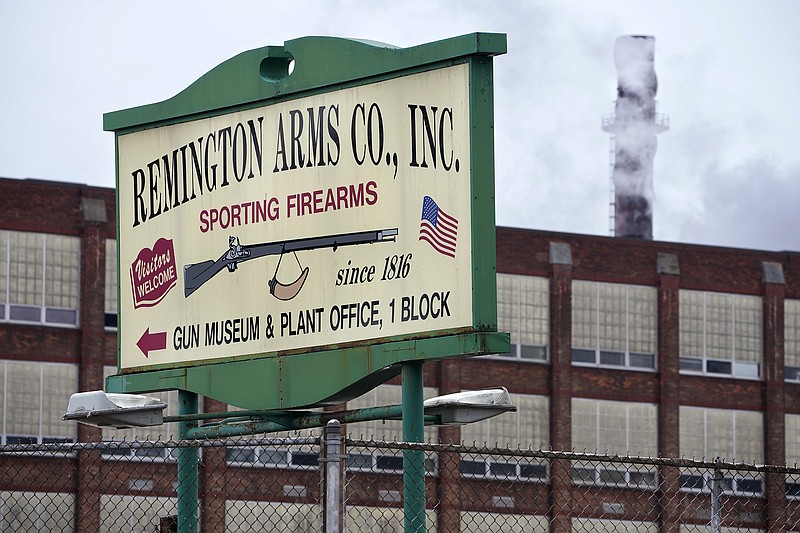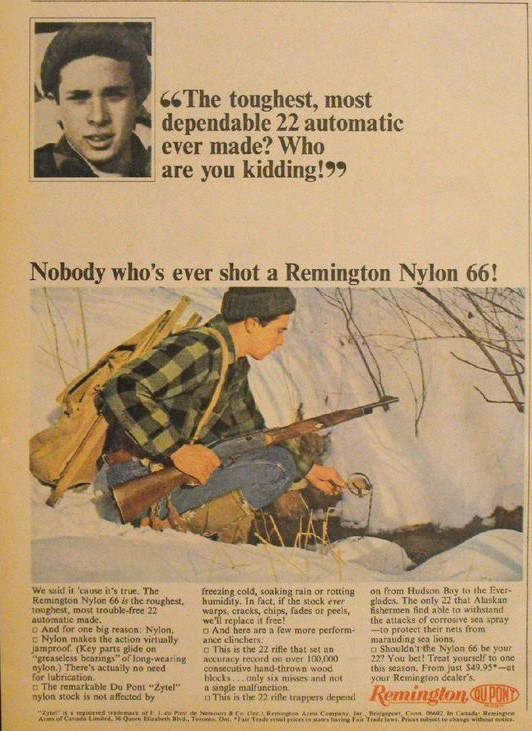I can remember it as clear as day: Turning the page in Outdoor Life magazine (it could have been Fur-Fish-Game), there was a full-page ad for a Remington .22 rifle, but not like one I had seen before.
This one grabbed me at my core and held on tight (just as the marketing people intended, I'm sure). Here was a young man in the snow setting a steel trap in a small creek. He had a pack basket on to carry traps, and he was wearing a wool jacket, rubber boots and blue jeans.
The picture kind of/sort of depicted me at the time, or at least how I saw myself. The only thing different was the kid in the picture had something I didn't have: a Remington Nylon 66 .22 rifle, this one in the popular Mohawk Brown model that was my favorite.
(READ MORE: Muskrat and magazine were life-changers)
In the 1950s, there was an engineer working at Remington who was a genius (in my opinion). His name was Wayne Leek, and somehow he had the vision to come up with a revolutionary idea for a new .22 rifle. Leek decided this new rifle had to be, among other things, lightweight (less than five pounds) and nearly indestructible with the stock and forearm one piece and integrated into the receiver. Oh yeah, a couple more little things: The rifle had to be relatively inexpensive and as accurate as possible.
No small order there, Mr. Leek!
Looking for the material to make this new wonder rifle, Leek went to the scientists at Dupont and laid out what he wanted from the material for this rifle. It would be suitable for molding into intricate shapes. It must have extremely high structural shear and impact strength. It must be highly resistant to abrasion and to distortion when subjected to extremes in temperature. And if ignited, it had to be self-extinguishing. (Again, no small order.)
The wizards at Dupont proposed their plastic-like material Nylon Zytel 101, which was part of the company's Nylon 66 series of materials, so hence the name, and the rest is history.
This material did many amazing things the garden variety hunters and trappers (like me) didn't know about. For starters, the bolt rode on two rails that Remington described as self-lubricating. The company also specifically said not to use any additional gun oil or lubricant as it might interfere with the gun's operation in extreme low temperatures, and testing showed the Nylon 66 worked great in these conditions.
I could not talk about this amazing little rifle with mentioning Tom Frye, who was a field representative for Remington and a very skilled exhibition shooter. In 1959, as the Nylon 66 was being readied to be trotted out to the public, Frye and his assistants embarked on a shooting torture test for the new rifle. Thousands of 2 1/2-inch-square wooden blocks were piled up at the test site, along with three new Nylon 66 rifles and a mountain of Remington Golden Bullet .22 ammo. One of seven helpers threw the first block into the air, and Frye dead-centered it with the first shot. At the end of day one, he had shot 3,000 blocks in the air with no misses.
That would have been amazing enough if he had stopped there, but he didn't. At the end of 12 days, Frye had shot 72,501 wooden blocks in the air and missed only three. The old record of 72,500 wooden blocks with nine misses, set in 1907 by exhibition shooter Al Topperwein, had been broken.
It is reported that the only maintenance the three Nylon 66 rifles got during this affair was that their bolt faces were cleaned with a toothbrush every 6,000 rounds to remove bullet lube and propellant fouling. There were no reported malfunctions during this testing.
If this is true my friends, that is amazing. Just as amazing is that it was reported that the nylon rails of the rifles showed no measurable wear from all this firing.
The Remington Nylon 66 .22 rifle debuted in 1959. It was immediately popular and sold millions, mostly in the popular Mohawk Brown, though also in other colors and variants. The initial price in 1959 was a whopping 50 bucks (oh that we could get them for that today). Used standard models can be found today online in the neighborhood of $500, with some of the rarer models going into the thousands.
Leek more than realized his vision of the accurate, nearly indestructible, moderately priced .22 rifle. The Nylon 66, which was produced until 1987, became Remington's best-selling .22 rifle ever, and it will always be considered one of the icons in the .22 world.
(READ MORE: There's no catch to the importance of a good .22 rifle)
My question is why can't modern-day gun companies find a way to do something similar to the Nylon 66 today? I mean, the technology is certainly far above what we had in the 1950s, right? Why couldn't someone duplicate the old Nylon 66 or use that idea as a basis for a similar firearm? Maybe some of the firearms company people see my words here sometimes and might consider this?
I'm telling you, a modern version of the Nylon 66 would sell. People would want this type of rugged, all-purpose .22 rifle for everything from hunting and target practice to keeping the varmints out of the hen house. Heck, I would buy two.
I am available to consult on this project for a small fee.
"Guns & Cornbread" is written by Larry Case, who lives in Fayette County, W.Va. You can write to him at larryocase3@gmail.com.

